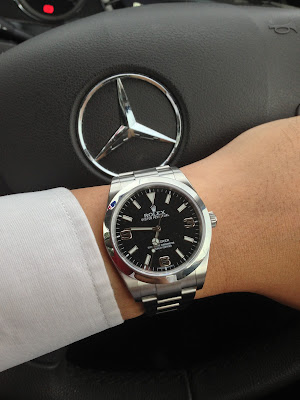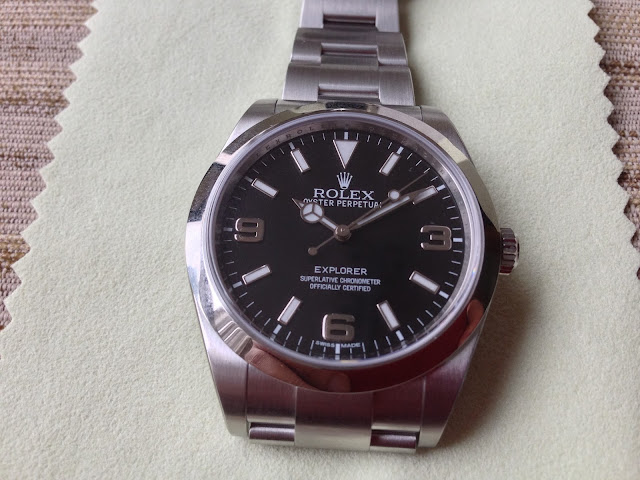 Recently I acquired my third professional Rolex Oyster piece, the Explorer 39 mm Reference 214270. With this acquisition, I have 3 of possible 6 Cyclops-less Rolex professional models in my collection. For high-end watches, I go to an authorized dealer to get it. Although it would be cheaper to source it from other channels or even get a second-hand piece, I don’t mind paying the premium because that is also part of the experience of owning such a watch in my opinion.
Recently I acquired my third professional Rolex Oyster piece, the Explorer 39 mm Reference 214270. With this acquisition, I have 3 of possible 6 Cyclops-less Rolex professional models in my collection. For high-end watches, I go to an authorized dealer to get it. Although it would be cheaper to source it from other channels or even get a second-hand piece, I don’t mind paying the premium because that is also part of the experience of owning such a watch in my opinion. Although the Explorer series have been in existence since the 1950s, the modern Explorer evolved in 1989 with the release of the 14270 that introduced Sapphire crystal, gloss dial with white gold surrounds to the markers, a redesigned 36 mm case and the 27 jewels Cal 3000 movement. The 114270 followed in 2001, upgraded with the 31 jeweled Cal 3130 and solid end links to the bracelet, but retaining the 36mm case and pressed clasp.
Another major upgrade to the Rolex Explorer range came in 2010 with the release of the 214270. The most obvious change being the increase of case diameter from 36 mm to 39 mm. The movement was also upgraded to the Cal 3132, along with changes to the dial, bracelet and clasp.
The watch’s new size is just right. Some would argue it’s a tad too big but to me it just about right. The design is excellent and the watch’s classic look is easily recognizable.
All surfaces, with the sole exception of the upper side of the bracelet, are polished. As with nearly all Rolex watches, the flat, sapphire crystal rises above the plane of the bezel, but its perimeter is beveled to deflect the force of a blow. Anti-counterfeiting details include the letters of the name “Rolex” engraved into the metal flange around the dial, the Rolex logo at 12 o’clock and serial number at 6 o’clock.
The rhodium-plated hands with a Mercedes-logo-like circle on the hour hand clearly contrast with the matte black dial. Although the crystal has no non-reflective treatment, it is not an issue as it is not a diver watch and the crystal is not that thick to disturb the passage of light anyway.
Made out of 904L stainless steel, the 904L is mainly used in the high technology, aerospace and chemical industries, where maximum resistance to corrosion is essential. A super-alloy, 904L is extremely resistant and highly polishable. Well and good but has it more scratch resistance than the typical 316L stainless steel? I don’t think so. Rolex should consider titanium construction instead in future models in my humble opinion.
Its movement, Rolex Cal 3132, is well protected under a fully threaded screw-down back. This movement differs from Caliber 3130, which powered the previous Explorer, because of its Parachrom hairspring and Paraflex shock absorbers. It’s based on the Cal 3135 with date display, which powers the Submariner and the Datejust.
Meanwhile, the Parachrom hairspring is made of a blue niobium-zircon alloy and is immune to the influence of magnetic fields. It is also claimed to be 10 times less susceptible to vibrations than a conventional hairspring.
Additional information on the Parachrom from http://www.watchtime.com:
“The Paraflex shock-absorption system (another Rolex invention) provides improved protection against sharp blows. This is the first time that Rolex has installed the system in a steel watch. The Paraflex mechanism had previously been used only in the Cellini Prince and the Day-Date II, both of which are available only in precious-metal cases. In the Paraflex system, the spring that returns the upper bearing jewel to its original position is symmetrical and smooth on both its faces so that it can be inserted on both sides, which makes the assembly process much easier. The spring is also less likely to jump out of its anchorage when a strong blow strikes the watch. Its shape, which extends over the center of the balance staff, makes it less yielding, which improves its ability to resist deformation. Furthermore, the spring bears two markings: one for the maximum oil level and one for the minimum. The Paraflex system is another example of Rolex striving to take what’s already good and make it even better.”
The movement is automatic and operates at a frequency of 4 Hz (28,800 beats/hour) and is COSC certified. Power reserve is stated to be 48 hours but I have not gotten the chance to test that yet.
The rectangular indices for the hours are filled with luminous material, and a large luminous triangle at 12 o’clock provides orientation for reading the time in the dark, although the rhodium-plated digits 3, 6 and 9 have no luminous coating. The hands and indices of the new model gleam brightly in the dark, thanks in part to the new Chromalight luminous substance, which debuted on the Sea-Dweller Deepsea and is now also used on the Explorer. It glows in a pale blue hue.
The lack of any complication apart from the hour, minute and second hands make this a very user-friendly watch. The crown is easy to unscrew and screw back; and has only two positions: one for winding; the other for setting the time. A hacking mechanism stops the balance, immobilizing the second-hand for easy to-the-second setting. The line under the Rolex “crown” logo on the winding crown marks it as the Twinlock type, which helps make the watch water-resistant to a depth of 100 meters.
The Explorer’s Oysterlock safety folding clasp is also easy to operate. First, open the protective bow with your fingernail; a second tug on the front part of the clasp triggers a lever mechanism to unlock it.
The “Easylink” lengthening system concealed inside the clasp is half of a link, which can be pivoted out without changing the appearance of the bracelet (see Figure 11). This five-millimeter extension can be a welcome addition when your wrist expands in warmer weather. Nevertheless, I would have preferred a system that could give me more to play with. Transplanting the Rolex DSSD “Glidelock” lengthening system into the Explorer would be an excellent substitute.
The bracelet has a completely satin-finished upper surface and polished flanks, which ensure that it perfectly matches the case. The lug width is 20 mm and is well balanced relative to the case size. A number of people commented that it should be larger but I disagree. If the case goes beyond 40 mm, it would be wise to go for a 22 mm wide bracelet.
When I first had the watch on my wrist, I was concerned about the likelihood of damage to the raised Rolex logo especially when it is a part of the release mechanism for the folding clasp. I tried to convince myself that the designers of Rolex have thought about it and we should not worry. Since I couldn’t find anyone having a problem with that, I guess I was just being paranoid.
This watch is definitely a candidate as the ultimate “daily watch”. This watch can be used in all occasions and situations. It looks regal in a formal setting yet is also look rugged in an adventurous setting.
Compared to its contemporary under Rolex’s Professional series watches, this watch does not look like a tool watch even though it is designed to be such. This is why I think the Explorer I is still the most brilliantly designed watch under the Rolex brand.
Photo Gallery












































Twitter: 3 Oct 2013
ReplyDeleteYour replica watch reviews are super helpful!
ReplyDelete